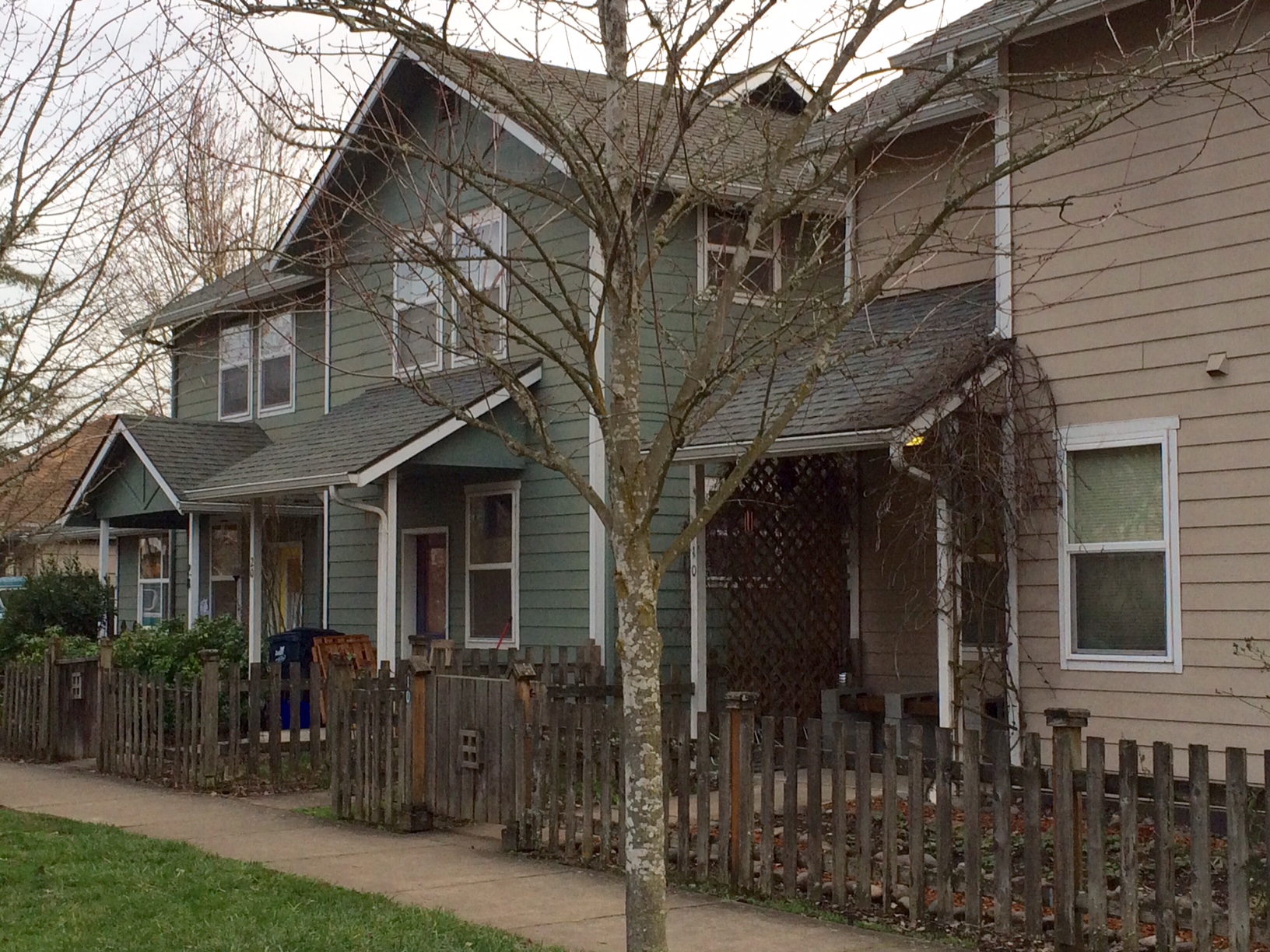Read Articles and News about Housing
Housing Choice, Missing Middle, and Housing Affordability
Housing Choice
There are a multitude of household types in Eugene, a wide diversity of income-levels, and different lifestyle preferences that require different housing types. About one quarter of households in Eugene are families with children under 18; another 30% are family households without children (i.e. either young or “empty-nest” married couples, or adult children living with a parent), and the remaining 45% are either individuals living alone, in a non-married partnership, or with roommates. Income levels also vary—about 30% of our households make less than $25,000 a year, with about 17% making over $100,000 per year. And individual preference varies as well… some people prefer to live in smaller homes in walkable neighborhoods, with perhaps less yard to maintain, while others prefer to live in a more suburban style environment.
Unfortunately, Eugene’s housing stock does not reflect the diversity of our population. Housing in Eugene consists largely of either detached single-family homes (roughly 67% of households live in these types of homes) or larger apartment/condominium complexes (about 26% of all households.) Only about 7% of our homes are attached or small unit apartment/condos. In addition, opportunities for ownership of housing other than a single family home are very limited—only about 5% of Eugene’s homeowners are able to live somewhere other than a detached single family home.
Demographic changes are also increasing the desire for smaller homes in walkable neighborhoods. As our Baby Boomer generation ages, the need for a home large enough for children and the ability to maintain a yard is reduced. The younger generation is less likely to drive than previous generations. Household size is decreasing—3.13 in 1960 vs. 2.3 now. At the same time, the size of houses is increasing— average home size has increased from 1,600 in 1970 to 2,200 in 2010. And few homes are located in walkable neighborhoods—less than 25% of housing units in Eugene are located in a neighborhood that has a walk score of above 50, and even within neighborhoods that are somewhat walkable there are many houses that aren’t walkable—even though the neighborhood itself might have some very walkable areas, there are other parts of the neighborhood that lack key elements of walkability. 85% of Eugene’s housing has been built since 1950, the heyday of suburban-style, single-family development.
Eugene lacks historical neighborhoods and housing forms such as townhomes, and options are extremely limited for anyone who wants to live somewhere other than single family home. Of 432 homes listed for sale on Zillow on June 7th, 2016, only 31 were condominiums or townhomes—over 90% were single family homes. Furthermore, housing is especially scares in walkable neighborhoods—of the eight neighborhoods in Eugene that have a Walkscore of above sixty, there were only 45 homes of any type for sale between them. The area covered by the proposed South Willamette Special Area Zone had one home for sale, and the area covered by the Jefferson Westside Special Area Zone had two. For anyone seeking to purchase a home in a walkable neighborhood, or in a form other than a detached single family home, options are limited.
Missing Middle Housing
The missing middle are types of homes that fall in-between larger multi-unit buildings—apartment complexes and condominiums—and detached single family homes. These are typically smaller dwellings, situated on smaller lots or in buildings with a few units. Examples include cottage clusters, accessory dwelling units, small lot homes, duplexes, triplexes and fourplexes, courtyard housing, and townhomes. Missing middle housing types work particularly well in walkable neighborhoods, creating a level of housing necessary to support walkability, while at the same time providing a residential feel. Descriptions of missing middle housing in general can be found here: http://missingmiddlehousing.com/ and examples of missing middle housing proposed as part of the South Willamette Special Area Zone can be found here: examples of housing types.
Unfortunately, not only is missing middle style housing very uncommon in Eugene, limiting residents ability to choose a home that best fits their lifestyle, the construction of new missing middle housing is very limited by our zoning code and land use regulations. The vast majority of residential land in Eugene is zoned for R-1 single family housing, and require comparatively large lots. In R-1 areas, even those types of missing middle housing that produce density levels consistent with limits for R-1 areas (such as duplexes, cottage clusters, and accessory dwelling units) have many limitations placed upon them by our code, and smaller units would end up on comparatively large lots. Limitations on medium density missing middle housing, such as townhomes and triplexes, are also in place, preventing them from being built in many areas designated for medium density housing. Read a test drive of the code that discusses restrictions on missing middle housing.
Affordability
Housing is considered affordable if no more than 30% of income is spent on rent or mortgage. However, given that different households have both different needs and different income levels, there is no one profile or price point for an “affordable” housing unit. A $500 dollar a month studio apartment would be an adequate affordable home for a single person working full time at an entry level job, but wouldn’t work for a family of four. A $250,000 home would be reasonable for a couple making $50,000 a year, but not for someone who is making $30,000 a year. And our lowest income residents would have trouble finding affordable housing no matter the price.
There are ultimately two different questions fall under the broad topic of housing affordability—how do we ensure that our lowest income residents receive the support they need to have a home? And how do we make sure that the market rate and diversity of housing options and price points are such that middle-income residents can find market-rate housing that meets their needs?
Housing affordability is becoming a crisis in many areas around the country. While the situation in Eugene hasn’t reached San Francisco levels, the supply of homes is decreasing, and the price is rising, particular in comparison to income. The median sale prices for a home in Eugene had increased was $250,000 in April of 2016, a 5.5% increase over the $237,000 median price just a year ago, and $47,000 more than it was five years ago—a 23% increase. By comparison, the median household income has only increased about 5% over the past five years. Rents are going up even faster—the median rent for a two-bedroom apartment has gone up 9% in the past year, and 28% in the past five years.
The situation is even more striking when you compare the situation over a longer time frame. The below chart describes the median household income and home cost in 1980, vs currently.
Note: Chart does not account for differences in interest rates between 1980 and 2016.
The increase in housing costs, combined with a slower increase in median income, has a particularly damaging effect on those who are seeking to purchase their first home, as well as renters. More than half of renters spending more than 30% of their income on housing in Eugene, and nationwide the age of first home purchase has risen to 33 years old. While it is not exclusively housing prices that are the root of this—increased debt and stagnating wages also play a large part—the lack of supply of suitable, affordable houses plays a major role. The supply of housing available in Eugene now is dangerously low—the current inventory of homes has been hovering around two months for much of 2016—with six months considered a balanced market.
Many factors affect the market rate for housing, but if we want to ensure that our residents can find homes that match their lifestyle at a price they can afford, two key elements need to address.
Quantity of Housing: At a base level, home prices respond to the laws supply and demand. When there are more people who need housing than there are homes, the price goes up. This applies on both a city-wide level (i.e. the median home price for the city as a whole goes up when there are more people then there are houses) and on a more specific level—for example, a shortage of desirable smaller homes in walkable neighborhoods make those homes a scarce commodity that will end up being priced higher than similar homes in non-walkable neighborhoods. Ensuring that we are able to build sufficient housing to meet demand helps ensure that housing costs remain reasonable.
Diversity of Housing: All other factors being equal, newer homes will cost more than older homes, larger homes will cost more than smaller homes, and homes with larger lots will cost more than homes with smaller lots. However, all other factors aren’t equal—fluctuating demand for particular types of homes in particular locations mean that smaller, older homes in desirable neighborhoods end up costing more than new, larger homes in less desirable locations. As discussed above, Eugene lacks a diverse housing stock. Ensuring that neighborhoods have homes of different types, sizes, and ages will help ensure that homes at different price points are available in our neighborhoods.
While there is a need to build subsidized housing units for low-income residents, to create housing that is affordable for middle-income residents, a new home doesn’t necessarily need to be a designated “affordable” home in order to increase the stock of affordable housing. Ensuring that there are enough homes of enough different types to meet demand will help hold prices overall at an affordable level, and will allow residents to self-sort based on their individual desires and budgets.
What is needed
Eugene’s population has grown by 38,000 people over the past 20 years. The area is predicted to add at least 34,000 more people in the next twenty years, who will need over 15,000 new homes. Under Oregon’s land use laws, sprawl is not an option. To accommodate our growth within the Urban Growth Boundary, and avoid the affordability crisis that other cities are currently struggling with, we need to increase the amount and diversity of our house. Specific actions include:
- Increase the supply of housing, particular missing middle and multi-family: Remove the road blocks in our zoning code that make it difficult or expensive to develop new housing, particularly missing middle housing and multi-family homes.
- Encourage infill and incremental development: Develop programs to encourage smaller development projects and incremental infill.
- Examine Inclusionary Zoning options and other programs to provide housing options for low-income residents: With the recent state-law changes regarding inclusionary zoning, examine options to encourage the construction of low income housing in Eugene.
Sources:



